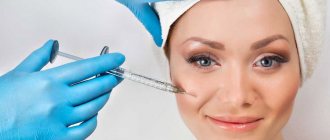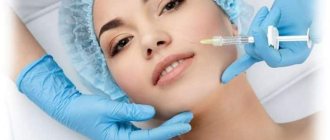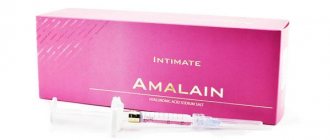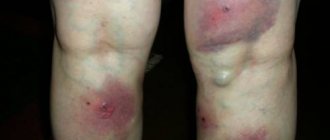Hyaluronidase is an enzyme that breaks down hyaluronic acid into fragments that are excreted from the body. It is found in connective tissues and helps balance hyaluronic acid in the body. It is for this purpose that cosmetologists often use it. Preparations with this component can improve tissue permeability, elasticity of the skin, and reduce swelling. For cosmetic purposes, this component is used in powder form, which is dissolved in water and injected under the skin. In this way, the enzyme hyaluronidase reaches connective tissue faster and helps rejuvenate the skin.
What problems require treatment with hyaluronidase?
Most often, patients come to the clinic after unsuccessful lip augmentation in two cases:
- When the drug shines through the mucous membrane because it was not injected deeply enough.
- When unsightly lumps appear on the lips because the drug was administered incorrectly or granulomas have formed.
Also, when introducing hyaluronic acid into different parts of the body, the following complications are possible:
- threatening necrosis of the skin and subcutaneous tissue around the lower lip;
- Tyndall effect or swelling under the eyes caused by too superficial placement of the drug;
- abscesses after increasing the volume of the cheeks;
- early and late allergic reactions.
Lumpiness of lips
Lip necrosis
Swelling of lips
Problems arise due to the administration of a low-quality drug or as a result of the administration of biological products under questionable sanitary conditions.
Many of these patients do not receive care from the esthetician who performed the cross-linked hyaluronic acid procedure because he is not qualified enough to resolve the medical problem in the event of an adverse event. A beauty salon is not a clinic! And a cosmetologist is not a doctor!
Types of enzyme and their actions
Hyaluronidase helps break down hyaluronic acid and maintains its balance in the body. Due to this property, cosmetologists often use it to reduce the volume of lips that have undergone unsuccessful plastic surgery. In these cases, resorption can take up to two days. It is often used in reproductive medicine, as it improves the ability of male reproductive gametes to enter the egg.
In nature, geologists find an enzyme of this substance in poisonous animals, which improves penetration into tissues and enhances the toxic effect.
Component types:
- Testicular type. This type of enzyme is found in the saliva of animals, fish, poisonous bees and snakes.
- A variety found in the saliva of leeches. This enzyme improves the penetration of hirudin and other beneficial substances.
- Microbial types. This enzyme is produced by staphylococci, streptococci and other bacteria.
Most popular: How to choose a foundation based on skin color and type
In medicine, these types of components are used for the manufacture of medications and their distribution in the patient’s tissues.
What complications after the injection of hyaluronic acid will hyaluronidase help with?
If you contact an experienced cosmetologist-dermatologist in a timely manner, he will be able to help in any situation, except blindness and skin necrosis. Of course, the introduction of hyaluronidase will not give anything if it was not hyaluronic acid that was used, but some other drug of unknown origin. Hyaluronidase acts on any cross-linked hyaluronic acid that is approved for injection in the European Union.
Hyaluronidase
Progress of the procedure
Before injecting an enzyme, the doctor must assess the patient's condition, conduct a visual examination and talk about the presence or absence of any diseases. It is necessary to take a photograph of the surface being treated. The injection is carried out using a needle, and the medication is produced in the form of a powder, which is diluted in a sterile saline solution and used immediately.
Most popular: Recipes for collagen masks at home
Often hyaluronidase is dissolved with procaine. When mixing the solution, do not allow foam to form and do not shake the glass container. After the solution is prepared, it can be injected into the problem area.
How quickly does hyaluronidase work?
The effect of hyaluronidase is immediate, but often causes swelling, so most often patients see the effect of complete dissolution of hyaluronidase only after 2-3 days.
- If it is necessary to dissolve only part of the hyaluronic acid, small doses of the enzyme must be administered every 10-14 days.
- If we are dealing with a serious complication and want to dissolve all the acid at once, large doses of the enzyme should be used.
Effect of hyaluronidase
Materials & Methods
Human biological samples
Normal blood and urine were provided voluntarily by healthy donors. Surgical tissue specimens were from Hôpital Curie, Paris, France. Synovial fluids from the knee joint from polygout patients were provided by Association 291 Inserme, Lyon, France.
Chemical reagents
HA from human umbilical cord H 1751, sialidase EC 3.2.1.18 type III from Vibrio cholerae N 7885. Polymerizing agent and kit MW-ND-500 for molecular weight markers in order not to denature the gel for polyacrylamide electrophoresis were from Sigma (St-Louis , MO, USA) stains-all®, No. 2718, were from Eastman-Kodak, (Rochester, New York, USA). All other chemicals were from Merck (Darmstadt, Germany).
Tissue secretions and body fluids
Tissues from various organs, leukocytes and platelets were homogenized in 4 volumes of 0.1% Triton X-100. The homogenate was left for 1 hour at room temperature and then centrifuged at 3000 g for 15 minutes at 4°C. The supernatant was concentrated using Aquacid and the final concentration was achieved on a Minicon B15. This extract was stored at -20°C. Knee synovial fluid was collected by knee puncture from patients with rheumatoid arthritis, centrifuged at 300 g for 10 minutes at 4°C, and stored at -80°C.
Electrophoretic studies
Multiple forms of HA were studied by the zymogram technique using 5% polyacrylamide 20 μg/ml hyaluronan gel (HA-PAGE). In some cases we used different concentrations of polyacrylamide, but the HA concentration was always the same. The principle of the method is that high molecular weight HA included in the gel cannot move into the electrical region. Electrophoresis was performed at pH 8.3, under conditions where hyaluronidases are inactivated. The gels were also tested at pH 3.5 and 37°C to allow HA degradation to occur. Then, the gels were stained with “Stains all” in the dark and washed with water. Hyaluronidase activity was shown by transparent pink spots on a blue background of undegraded hyaluronan. A rapidly moving white spot was observed in the serum of the electrophoretic sample, consistent with a sialic acid-rich glycoprotein unrelated to hyaluronidase activity.
Sialidase treatment of human serum and tissue hyaluronidase
The desialization method was performed as previously described. Then the GC-PAGE zymogram technique was used.
Potential sites of N-glycosylation by hyaluronidases
The hyaluronidase amino acid sequence was aligned using the multiple alignment program CLUSTAL W (1.74). Potential N-glycosylation sites were found in the PROSITE database. Human hyaluronidase reference sequences were Hyal-1 (plasma), Hyal-2 (lysosomes), Hyal-3, Hyal-4, Hyal-mn, PH-20 (sperm) (GenBank accession numbers U96078, AJ00099, AF36035, AF09010, AF51769 and S67798, respectively) and meningiomas (SwissProt accession number AF36144). The mouse hyaluronidase reference sequences were Hyal-1 (plasma) and Hyal-2 (lysosomes) (GenBank accession numbers AF11567 and AJ00059) and PH-20 (sperm) (SwissProt accession number P48794). Rat lysosomal hyaluronidase Hyal-2 (SwissProt accession number AF34218), frog liver hyaluronidase Hyal-2 (SwissProt accession number AF134981). For the Cynomolgus monkey, guinea pig, rabbit, and fox hyaluronidase PH-20 sequences, the SwissProt entry numbers were P38568, P23613, P38566, U41412, respectively. For wasps, white-eyed hornets and hyaluronidases from honey bee venom, the compared sequences were with SwissProt entry numbers P49370, P49371 and Q08169, respectively, and for Caenorhabditis elegans with SwissProt entry number Z49071.
Incorrect administration of hyaluronic acid – when and who to contact?
Below is a list of the most alarming symptoms that - if they occur after the injection of cross-linked hyaluronic acid - should prompt the patient to immediately seek help from a specialist experienced in treating complications in the field of aesthetic medicine:
- pain that is not relieved by over-the-counter pain medications;
- increased swelling of the face;
- dyspnea (shortness of breath);
- whitening, decrease or increase in skin temperature over the injection site of hyaluronic acid;
- suspicion of an abscess;
- heat.
Unsatisfactory aesthetic effect, asymmetry, visible lumps and translucency of the drug do not require urgent intervention.
The only correct address where you can eliminate the consequences of complications after using hyaluronic acid is the office of a dermatologist with experience in treating complications in the field of aesthetic medicine.
Share link:
Contraindications
But still, like almost any substance, hyaluronidase is not recommended if the patient has a tendency to allergic reactions, pregnant women and nursing mothers. It should not be treated if a person has cancer, a chronic or acute inflammatory process in the body, or there is hemorrhage in the area of the nasolabial folds.
Doctors often combine medications with this enzyme and other drugs to improve their absorption. But it is worth remembering that hormonal drugs taken by the patient can negatively affect the absorption of the substance.
Side effects
According to reviews of hyaluronidase, side effects may occur. This remedy may cause:
- dizziness;
- nausea and vomiting;
- chills;
- decreased blood pressure;
- tachycardia and ventricular fibrillation.
It is worth noting that negative consequences are quite rare. However, allergies can be quite serious. There is even a risk of anaphylactic shock. Redness and swelling are sometimes observed in the injection area.
COLLAGENASE + Vit C + DMAE (PBSerum LIFT)
This combination of components has a pronounced strengthening effect.
As we can see, PBSerum Triada, when used in combination, affects the 3 main components of fat deposits: stretched and fat-filled cells, dense fibrous bridges between them and edema. It also helps restore skin density and elasticity.
In addition to complex use, each drug can be used separately and in various combinations depending on the problem and objectives.
The drug is safe and well applicable in the correction of problem areas of the face.











